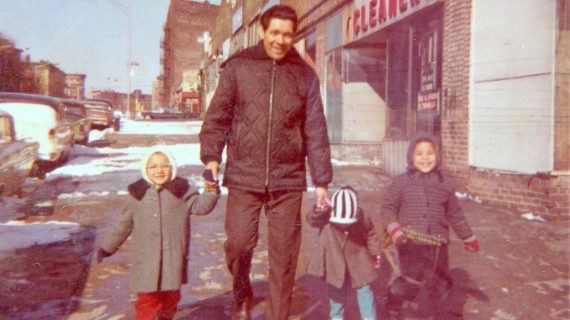Today we are pleased to introduce Sergio Gonzlez as part of the Wisconsin Historical Museum’s History Sandwiched In Lecture Series. The opinions expressed today are those of the presenters, and are not necessarily those of the Wisconsin Historical Society, or the museum’s employees. Sergio M. Gonzalez is a Doctoral candidate in the Department of History at the University of Wisconsin-Madison, and an organizer for the Dane Sanctuary Coalition. Faced with an immigration, working class, and religious history, his research investigates the development of Milwaukee’s Latino community, and their efforts to create social justice movements throughout the 20th Century. He is the author of Mexicans in Wisconsin, recently published by the Wisconsin Historical Society Press. So, please join me in welcoming Sergio Gonzlez. (audience applauding)
Good afternoon, everybody. Good afternoon, everybody. Hi there. Hi, yeah.
This is, I guess, officially my first book talk, so it’s a pleasure to be with you today. Book just came out on Friday. And what I’d like to do here with you today, is share a little bit, some of those stories that come out in that book. And I’d like to begin our time together today in the hot summer of 1949, in the agricultural town of Waupun, in central Wisconsin. Our story is going to begin with migrant worker families. Texas born, and of Mexican descent. People who call themselves Tejanos. So, Texas-Mexican, Tejanos. During the summer of 1949, a group of migrant families ventured into the Fond du Lac Park, to cool off at the county pool.
They were met, however, by a custodian named Seymour Patrick, who refused to allow the migrant children and their families, to swim. When asked by the local press why he had restricted their entry, the custodian declared, quote, “They say these people are American citizens. When you become an American citizen, you should talk the language. Lots of these people don’t.” Patrick explained to local press that the youngsters, who would have to confine their play to the Waupun City Park, saying that some, quote, “White parents didn’t want their children to play with the Mexicans, because the fears of these children spreading polio among city residents.” Patrick threatened to close the entire pool, rather than to allow Tejanos to enter. The Fond du Lac custodian’s actions and comments prompted the swift backlash from community organizations and town officials. The League of Women Voters of Waupun appealed the park officer’s restriction of migrants to the county board, and the League argued that Tejano children’s status as American citizens, entitled them to the, quote, “Same privileges other citizens of Wisconsin have.” Within a matter of days, the Fond du Lac County Parks Committee issued a statement, refusing to tolerate any discrimination whatsoever in county parks, and forcing the offending custodian to resign his position. County officials worried about the negative images that, what they call the quote, “racial difficulties in their communities,” might send to the broader public. And specifically they were worried about what this image might send to migrant families still living in Texas. In other words, those migrant workers who might not decide to come to Waupun because of the situation.
To review the migrant situation in Waupun, local politicians establish a community council on human relations to review the issue. Comprised of civic leaders, and members of religious organizations, the council expressed a desire to quote, “Break down social prejudices by working “across racial lines, and increase contact between the Waupun community and Tejano migrants.” The common council developed a summer school program for migrant children for the 1950 and 1951 summer season. Teachers arrived in Waupun to begin instruction mid-June, using loaned school buses to transport migrant children to the local school. The teachers taught reading and math, and they emphasized English language instruction, which is a little ironic considering what the custodian had said earlier. Each day at noon, teachers shuttled the school children to the city park, where they ate lunches with the local Waupun children, as a planned form of inter-ethnic interchange. In addition to classroom instruction, staff organized weekly family nights at each participating migrant camp, that included baseball games, community singing, and films. Their summer school lasted for eight weeks, ending with a celebratory picnic at the closing of the season. Despite the volunteer’s hopes however, that the summer program would break down what they call this wall of opposition against migrants, and instead be replaced with what they called, a bridge of understanding. They were very poetic with their language.
Late in opposition towards the outward support for the inclusion of the Tejanos’s and Waupun’s community continued throughout the early 1950s. It’s a very ironic picture from the Milwaukee Journal. Canners who lived in the area, who worked in the area, remained indifferent to the reforms, and local merchants largely avoided, or they shunned the migrants during their stay in the town. Mayor Frank Trilling, of Waupun, who had been outspoken in his support of migrant issues, and the council’s work since 1949, paid the ultimate political price in 1951, when he lost his bid for reelection, in large part because of his support for the migrant workers. Ironically, this is how the state media portrayed Waupun Human Rights Council’s work. A problem solved. Wisconsin, long considered America’s dairyland, had the potential to earn the moniker of the nation’s salad bowl, in the 1950s and 1960s, thanks in large part to the work of Mexican-descent laborers. The state-central counties of Portage, Waupaca, Adams, Waushara, Marquette, Green Lake, and Wood, relied every year on more than 10,000 Tejano migrant workers to plant, harvest, and process potatoes, lettuce, carrots, onions, cucumbers, peppers, and sugar beets. Despite their importance, the development of the state’s agricultural industry however, Mexican-descent workers like those in Waupun, arrived in Wisconsin to find themselves in a tenuous economic and social standing, as they faced substandard housing, poor wages, and discrimination of the receiving communities.
Throughout the 1950s, religious organizations and state commissions grappled with how best to integrate these migrants into the rest of the state. Wisconsin advocates argued that the exploitation of migrant families effected not only the migrants themselves, but also left what they called an irreparable scar on the moral character of the communities that received them. For those with whom a moral or a religious argument had no standing. Activists and state commissioners instead turned to financial considerations. So, organizations like the Governor’s Commission on Human Rights reminded Wisconsinites that the economic implications of keeping Tejanos on the margins of society. Rebecca Barton, Director of the Governor’s Commission, for example, hoped that growers would come to understand that, “It was good business to treat the migrant decently, because he’s an economic asset.” Despite the best efforts of advocates, most of Wisconsin’s growers and canners struggled to recognize the economic importance, much less the humane significance of offering even the most basic of guarantees to the migrant workers who traveled to their camps every year. Throughout the 1950s and early 1960s, organizations like the Catholic Church, the Wisconsin Council of Churches, and the Governor’s Commission on Human Rights were mostly unable to modify the systemic issues that allowed for migrants to earn less than a living wage, that forced them to live in, and work in sub-human conditions, and made them pariahs in many of the communities in which they traveled to. Ultimately, it would be the workers themselves who would push for substantive change. By the mid-1960s, Tejano migrants who called Wisconsin home every summer, began the process of organizing themselves into a labor union to fight for change on their own terms.
Their organization, Obreros Unidos, who we’ll finish our talk with today, believed that the dramatic shifts in policy, and not just changing the attitudes and minds of Wisconsinites, would be needed to in fact make meaningful transformations in Wisconsin’s society. Before we get to the 1960s though, we’re gonna start a little bit farther back. Midwestern growers had recruited Mexican-descent people since the earliest decades of the 20th Century. During the late 1920s, and throughout the 1930s, approximately 3,000 Tejanos, people of Mexican descent from Texas, came to Wisconsin annually. The United State’s entry into World War II heralded a dramatic demographic shift, as well as an expansion of agricultural production in the state. So, from 1940 to 1946, approximately 140,000 people left their rural communities, and moved into urban centers. They were looking for jobs, they were looking for better paying positions, and they were looking for new opportunities. This was happening all across the United States. And political leaders in Washington were dealing with these wartime demographic changes.
And the manpower shortages that threatened to put the United States in a very perilous position during World War II. Their solution came through guest worker programs from Mexico and the Caribbean. These multi-national agreements allowed Wisconsin farmers to enlist male workers from Mexico and the Caribbean, as well as prisoners of war from Germany, to work primarily in the harvest of sugar beets and cherries, as well as pea and corn canneries. The most important of these agreements came in 1942, when the United States signed the Mexican Farm Labor Agreement. Also known as the bracero program. The program, which lasted throughout the war and well into the 1960s, brought hundreds of thousands of Mexican nationals as guest workers to the United States. And while most of those workers ended up working in California, and the Southwest, and along the Pacific Coast, Wisconsin contracted 4,800 braceros throughout World War II. Under the negotiated contract stipulation set by the US and the Mexican governments, Mexican migrant workers coming to the United States were guaranteed paid transport and food while traveling to their work site, and they were promised to be paid the local minimum wage. The US government also promised to extend the same benefits to Mexican workers regarding housing, sanitation, workplace safety, and medical attention as was available for US citizen workers.
For those bracero workers who actually arrived in Wisconsin in the 1940s however, those explicit contractual obligations never actually appeared. Laborers arriving yearly by railway, would first come to Chicago in early April. Where because of the constant movement of soldiers going out to the front, and supplies headed out to war, they were forced to wait for days on the train station platform, with access to regular meals, and without any sort of shelter. Eventually arriving to their work sites here in Wisconsin, these Mexican laborers immediately found reason for concern. Instead of finding adequate living quarters, Mexican workers were forced to live in repurposed box cars with poor ventilation, and inadequate restrooms. They found unreliable medical care, as company doctors slackened the standards for medical examinations. They do things like when someone would come with some sort of bronchitis, they would say this is just a bad cold, and put them back to work. Because this was an investment that the employer had made to bring the worker to the United States. To protect its citizens working in the Unites States, the Mexican government sanctioned those states that failed to hold offending employees accountable.
The Mexican government penalized Wisconsin multiple times throughout the 1940s and 1950s, because of both working conditions and the social circumstances that both Mexican-descent workers from Mexico, so Mexican nationals, but also Mexican-descent citizens born in the United States, like those Tejanos we talked about in Waupun, faced throughout Wisconsin communities. So a number of times, Wisconsin was actually blacklisted from receiving Mexican workers from the Mexican state. Other states on that list of blacklists, were Texas and Louisiana. So maybe not the best place Wisconsin wanted to find itself if terms of employee relations. Following the expansive agricultural dive of World War II, the number of Wisconsin crops raised and harvested for canning leapt upward in the subsequent decades. Before the start of the war, individual farmers could harvest their own crops, and deliver them to canneries the following day. Throughout the 1950s however, farmers were responsible for hundreds of thousands of acres of field with peas, sweet corn, cucumbers for pickles, cherries, snap peas, lima beans, sugar beets, and tomatoes. And who did these farmers turn to for migrant work? People from Texas. Growers and canners concentrated the recruitment efforts on these Texas-born, Mexican-American families, also known as Tejanos.
In the immediate post-war years, Tejanos accounted for nearly 85% of migrant workers here in the state. Throughout the 1950s, between 10 to 14,000 migrant laborers made the way to towns like Wautoma, Oconto, Rosendale, Lomira, Fox Lake, from Texas every single summer, helping the state keep its lead in the canning of peas, sweet corn, and beets. The migrant crews usually consisted of groups of families, ranging from 10 to 30 men, women, and children, who traveled by car, or by covered truck, or sometimes by uncovered truck. Nearly all workers that arrived from Texas came in family units, all of whom worked in the fields, including the children. These families often found two forms of housing available for them in Wisconsin in the 1950s. The first, the more desired type, was provided by the larger growers. And these locations, “adequate lodging,” meant giving an amount of space for a person, having a weatherproof unit, located on a well-drained piece of land. So that was that standard, right? A ceiling, well-drained piece of land. The housing would most likely have electricity, although not always.
Would have some sort of accessible running water. Would have some form of beds or bedding. Adequate toilets and garbage facilities. And windows that could be used to keep out the bugs in the summer seasons. This form of lodging, as one researcher who went into the camps noted, was provided by employers who saw migrants as quote, “fellow human beings”. And who believed that they were employing laborers and respectful partners, in an honorable enterprise. There was a second form of housing available, however. Often provided by smaller growers. Often with a much different reality for migrants.
Researchers refer to these as, “hovels which defy description”. These arrangements were typically any type of shack, worn out building, or abandoned dwelling a grower could cobble together. No care taking, no care was taken to provide running water, sanitation, or bedding for migrant families. This is a space from the 1960s, when we could expect some running water, but you can see the shower is right there, not necessarily ones that would respect a person’s privacy. According to a 1948 report, 1/3 of the housing units provided for migratory families were unfit for human occupancy. Faced with these conditions, migrants found no form of recourse through Federal or Wisconsin laws regulating their working or camp conditions. Migrant workers actually, throughout the– most of the 20th Century were excluded from most Federal protective legislation, especially those passed during the New Deal era. Including things like the Fair Labor Standards Act, the Social Security Act, and the National Labor Relations Act. And we can talk about that in the question answer at the end, why they were purposefully kept out of those pieces of legislation.
And so because they weren’t a part of that legislation, migrant workers lacked any protections in regard to minimum wages, workman’s compensation, old age and survivor’s insurance, unemployment insurance, and collective bargaining rights. And we’re talking about American citizens, people born in Texas. People who theoretically should have access to those stipulations. Besides their working conditions, Tejano migrants found a less than welcoming experience outside of their camps as well. The most public example of racially-based discrimination occurred, believe it or not, in Door County. Where orchardists had turned Tejanos and African Americans from the US south, to compensate for a growing crop yield. By the early 1950s, Door county’s one million cherry trees produced between 20 and 50 million pounds of cherries per season. Imagine that. 20 to 50 million pounds of cherries per season, placing the area third in the national cherry production.
More than 10,000 seasonal workers came to Door County every single season to help harvest those crops. Migrant laborers and their families, brought to this idyllic region to pick the bumper cherry crop, soon came to pose what the Milwaukee Journal referred to as the “Cherryland Problem”. Crammed into segregated, unsanitary shanties, and living without proper medical attention, migrant workers struggled with unfulfilled wage promises, often being paid at less than half the rate at which they had been contracted. Camp owners offered the well-worn canard that segregation in their camps was only due to racial difference. And workers just preferred to live among people of their own kind. African-American migrant workers from the US south faced perhaps, the most visceral form of discrimination. In 1948, a local gang of Door County residents loaded up one crew of black workers into trucks, and drove them to the county line where they were told to, “Hit the road, and not return.” Tejano youngsters also faced the ire of local white skilled children, who reportedly called those migrants, bean pickers. And surrounding towns in the county, community businesses instituted de facto segregation policies. So, in eating establishments in Door County in 1949, you could find signs that said, “Whites only,” and, “We cater only to whites,” in the windows.
Resort owners were also bitter at the presence of these migrants, claiming that African-Americans and Tejano workers drove away their customers, even though few if any of these people ever went into resort areas in Door County. To better address grievances from the migrant community and create programming that might prevent future tensions from expanding between Tejanos and Wisconsinites, the state’s Governors turned to state commissions, with representation from bureaucrats, clergy, civic groups, and employers. Principal among these groups was the Wisconsin Governor’s Commission on Human Rights. This organization however, lacked any sort of legal power to enforce civil rights law. So, they had the title, but no enforcement strategies. So, their number one way of getting people to change their attitudes and change their actions was through education. The Governor’s Commission’s first major migrant initiative began in the fall of 1949, when they surveyed the state’s migratory worker history, and state services. And they published their findings in 1950, in a report titled, “Migratory Agricultural Workers in Wisconsin: A Problem in Human Rights.” The commissioners described sub-human living conditions, and employers who forced migrants into these conditions upon their arrival in Wisconsin. Along with unequal bargaining power for laborers, the absence of educational opportunities for migrant children, and lacking public health facilities.
This is one– The reporters and authors published this. “The successful assimilation of the migrant worker and his family into the community to which he has come presents virtually the same problems as the acceptance into the community of other migrant groups.” Minority groups, pardon me. “Having migrated in order to better his economic status, he is often disillusioned to find that he has no friends, no familiarity with the culture outside of his own group.” And their conclusion to the report, the Governor’s Commission expressed hope that their work would help migrant workers be no longer considered, “The displaced persons of America”. The unsettling living and working conditions described in the Governor’s Commission’s report, led to the creation of permanent governmental committees and the passage of new laws designed to protect migrant families in Wisconsin. At the request of the commission, Wisconsin Governor’s appointed several state committees throughout the 1950s, to act as clearinghouses for migratory workers, and to aid in accorded planning between state departments. Like the Governor’s Commission on Human Rights however, none of these groups had any sort of enforcement power. So the inner agency migrant committee had no ability to actually regulate migrant living conditions, migrant working conditions, or how people were accepted into communities. With state agencies relying upon this ineffective regulatory apparatus to better worker’s lives, religious organizations also stepped in to see what they could do to help migrant workers. Catholics and a wide variety of Protestant denominations entered the field to administer to the spiritual, and at time physical needs, of arriving migrants throughout the 1950s.
So, the Division of Home Missions of the Non-denominational National Council of Churches, initiated migrant programs throughout the 1950s, as did Catholic churches throughout central Wisconsin. Unfortunately, most of these efforts by these churches, and by the state commissions, as I mentioned earlier, had no actual regulatory power. They had no executive power to actually enforce these actions. So it usually relied upon education, and as you can see here, relying on people’s morality. Asking them to act in a form that represented their Christian morality, or their standing within the state. It wouldn’t be until 1960, when Wisconsin Governor Gaylord Nelson created the Governor’s Committee on Migratory Labor, that we saw some actual change and actual lobbying at the state-Senate level. This Commission, the Wisconsin Governor’s Committee on Migratory Labor was chaired by Elizabeth Brandeis Raushenbush, a University of Wisconsin economics professor, and a veteran on migrant advocacy. In this group, included representatives from various state agencies and religious organizations. With a more activist membership, the Governor’s committee presented a new opportunity to develop a clear lobbying arm for migrant workers.
And their first fight was in promoting public schools, or public funding for migrant schools for migrant children throughout the summers of the early 1960s. So you see here from 1961 in Manitowoc, these committees were actually able to harness some of the money, some of their resources, despite the efforts of growers to not push any money into these programs. Much of these earlier initiatives however, were patchwork. And they served mostly as just band aids to a larger systemic issues that allowed Tejano migrants to continue in a form of second class citizenship. It would ultimately be farm workers themselves that would accelerate calls for action. Chief among these mobilizations were the actions of thousands of California migrant farm workers that joined the National Farm Workers Association, what we now know as United Farm Workers. In the early 1960s, that was the farm union that was led by Cesar Chavez and Dolores Huerta, and numerous other migrant leaders. These workers called first for a state-wide and then a national conversation on migrant farm workers’ rights, to organize into unions, and to collectively bargain with their employers over their working condition. That movement that began in California eventually spread to Wisconsin as well.
Among those migrants here in Wisconsin who decided to fight for a better chance for migrants across the state, was Jesus Salas, a third generation Texas-born Mexican-American farm worker from central Wisconsin. Salas’ parents had been migrant farm workers who traveled to the state, since the 1940s, but had settled permanently in Wautoma in 1958. Salas had previously served during the summers in daycare programming before 1965, joining Wisconsin professor, Elizabeth Brandeis Rausenbush, to investigate migrant work in the Wautoma area. And it was working with these committees that he realized the individual situation of migrants had larger implications at the state level. And so in the summer of 1966, Salas joined with a group of migrant workers, community organizers, and university students to begin a union organizing drive in central Wisconsin’s cucumber industry. This push represented the first sustained effort to form a migrant farm worker labor union in the Great Lakes region. The migrant workers chose Obreros Unidos, or Workers United, as the name of their new organization. And their slogan was “La Raza Se Junta” or the people rise to the cause. They faced of course, numerous obstacles and rallying support.
The biggest one among them being the fact that migrant worked as transients, so it’s hard to get people in one location to talk to them about migrant organizing. And so Salas, what he would do, is he would organize both in Wisconsin when migrant workers were actually working in Wisconsin, but he would travel down to Texas, and organize with them in their home communities before they came northward. As Obreros grew their worker base in Wautoma and in Texas, union leadership made the decision to organize a dramatic march in the summer of 1966 to publicize the demands of migrant workers. Migrant workers had four key demands. A higher minimum wage, coverage under the state’s workman compensation health insurance laws, migrant labor representation on the Wisconsin Governor’s Committee on Migratory Labor. And public sanitation facilities for migrant workers in Wautoma. Those seem like pretty simple requests, but they were radical in 1966. Over five days, 24 marches representing over 5,000 migrant laborers employed in Waushara, Portage, and Marquette counties, walked the 80 miles separating their camps from the state’s capital. The workers referred to their protest as a “march for respectability for Tejano migrants”.
I just wanna show you some quick images here. The 1966 march effectively publicized the issues that migrants had, and it began a multi-year process of organizing actual workers throughout the state. Throughout places like Almond and Wautoma. And the marches that began in 1966 were very much imbued with rising social justice and civil rights movements of the 1960s, including Chicano power, and these organizations were often times in conversation with organizations in California, like the United Farm Workers. So some more images. And one of the things that I’d like to emphasize is that these migrant organizing events, these union organizing drives were not simply led by the people who worked in the fields. They were completely family events. As I mentioned earlier, because migrant units were often consisted of an entire family. It was not just the mother or father working in the field, but it was often the grandmother, and the children who are also part of these organizing drives.
We’re now a decade removed from Obreros Unidos march from Wautoma to Madison. But Mexican-descent workers continued to play a vital role in our state’s economy. Wisconsin has shifted from being a major vegetable grower, and processor to the nation’s number two dairy state. These dairy businesses operate 24/7, year ’round. And they require a constant and reliable labor force. Just as in the middle decades of the 20th Century however, our state’s rural population continues to shrink, and cannot staff the needs of the dairy industry. Because of that, 80% of hired help on large Wisconsin dairy farms are actually made up of immigrant labor, the majority of whom come from Mexico. A large percentage of those workers are undocumented, here in the country without legal standing. Despite their economic importance, their centrality to the state’s wellbeing, these Mexican dairy workers have currently come under the cross hairs of state legislators, intent on cracking down on undocumented immigration.
Republican State Senators and assembly people have proposed two pieces of legislation. I’m sure you’ve seen this is news. Senate Bill 275, and Assembly Bill 190, which targets so called sanctuary cities. Cracking down on local laws, aimed at protecting undocumented immigrants. The legislation focuses on municipalities that refuse to assist Federal immigration enforcement, with violations resulting in a fine of $5,000 a day, from state funding. These proposed laws have drawn protests from immigration activists, like Voces de la Frontera, and Immigrant Allies. But they have also drawn protests from the employers themselves. And so on October 12th, just last week, hundreds of opponents of this legislation descended on the State Capitol right down the street here, to voice their disapproval. Among the people who came to speak was Buffalo County Dairy Farmer John Rosenow, who said in testimony that the legislation would make it even more difficult for him to fulfill the work that he needed done.
He said, “We dairy farmers need immigrants to work on farms to help the industry to continue to be robust.” Rosenow is of course is as correct today, as if he would have said it in 1947. Without Mexican laborers, documented or undocumented, Wisconsin’s dairy industry as well as meat packing, and food processing plants in rural parts of the state, would collapse. And so once again, even though we are more than 50 years removed from that initial fight, workers of Mexican descent, brought to the state, are seen as an economic necessity, but they find themselves– find it impossible to exist and prosper in Wisconsin. Unlike those former Tejano migrants who traveled to Wisconsin every year growing and harvesting in the summer seasons, many of the people who are being targeted today, have lived in the state for decades. They’ve bought homes, their children attend schools, and they have become vital members of their communities. And so bills like SB275 and AB190 have had the effect of placing undocumented workers in the state, in a state of social limbo. As workers are terrified, and families live in constant fear. I would imagine if the Governor’s Commission on Human Rights were still in existence today, it’s possible to believe them issuing another report. Calling on Wisconsinites to recognize a new problem in human rights. A crisis in our state’s ability to welcome those very people that we rely upon to keep our economy and our society fighting. Thank you. (audience applauding)
Search University Place Episodes
Related Stories from PBS Wisconsin's Blog

Donate to sign up. Activate and sign in to Passport. It's that easy to help PBS Wisconsin serve your community through media that educates, inspires, and entertains.
Make your membership gift today
Only for new users: Activate Passport using your code or email address
Already a member?
Look up my account
Need some help? Go to FAQ or visit PBS Passport Help
Need help accessing PBS Wisconsin anywhere?

Online Access | Platform & Device Access | Cable or Satellite Access | Over-The-Air Access
Visit Access Guide
Need help accessing PBS Wisconsin anywhere?

Visit Our
Live TV Access Guide
Online AccessPlatform & Device Access
Cable or Satellite Access
Over-The-Air Access
Visit Access Guide
 Passport
Passport












Follow Us